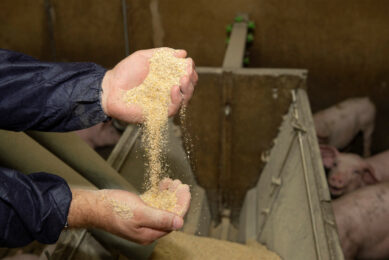Moisture retention for higher feed mill efficiency

The goal of animal feed producers is to achieve better nutrient utilisation and animal performance plus an optimised resource use. When it concerns the internal operational process, feed mill efficiency is among the primary issues. How can we retain the moisture level so that the total weight loss is limited, especially in light of increasing raw material costs?
By Paul Koolen, Product Manager Fylax, Selko Feed Additives
The moisture retention in feed may be associated with one simple action and result, but there are several other interesting aspects besides the actual moisture content. These are feed quality, economic consequence due to retained finished feed weight, reduced energy usage in the feed mill, long lasting antifungal effect, and more recently, an automated dosing and control system.
Moisture profile of feed
Moisture content is an important indicator of feed weight variation between the originally purchased raw materials and the finished products to be supplied to market. Raw materials have an average moisture content of 12%. A typical moisture profile of feed during manufacturing process is illustrated in Figure 1 (see attached pdf). The moisture content of raw materials drops during the process of grinding and mixing, subsequently increasing during the conditioning.
The sprayed steam, however, evaporates again while being cooled. As a result, the moisture content of the finished product is usually between 0.5-1% lower than the initial moisture content of the raw materials. Figure 1 (see attached pdf) shows a gap between the two lines; the higher moisture content throughout the processing is achieved by adding a surfactants mixture to the feed.
Surfactants acting as a pelleting aid
(Figure 2 – see attached pdf) Use of surfactants in combination with the added moisture is an effective method to improve the moisture retention in finished feed. Surfactants are known to reduce the surface tension of water, allowing better penetration and improved distribution. The surfactant ensures that the water is evenly distributed throughout the feed material, not only remaining on the surface of the particles. The dispersion of non-corrosive, safe to handle organic acids in water enhances the quality of the final feed without causing adverse effects on the shelf life. The surfactants mixture also acts as a lubricant in the pelletiser.
Other advantages of adding the surfactants mixture are the economical and energy savings. On average the pelletiser accounts for half the energy consumed at a feed mill. The hydrating solution leads to less friction in the die of the pelletiser which results in less amperage used and higher throughput.
Sufficient moisture content and temperature of the conditioner using saturated or dry steam is key in achieving gelatinisation of starch and reaching glass transition temperature by improving the hardness and durability of the pellet. The surfactants act as a pelleting aid to distribute the added water and contribute to achieving the sticky effect via the gelatinisation during the conditioning process.
One issue for consideration is a poor conditioning process resulting in decreased durability and hardness of the pellets, more fines can be created during production. However, the surfactants control ‘free’ water content to a safe level to overcome mould growth during storage of feed.
Long lasting antifungal effect
The presence of moulds in feed is a persistent problem if the feed is stored for several months under challenging circumstances related to oxygen, temperature and humidity. Moulds consume the main ingredients in the feed which leads to deterioration of the nutritional quality.
Controlling moulds requires a somewhat different approach for organic acid than controlling bacteria, as the acid not only needs to pass the cell membrane but also the outer cell wall. Thus, activated propionates held in micelles were developed by Selko Feed Additives and Nutreco Ingredient Research Centre.
These micelles increase the porosity of the mould cell wall, destabilising the underlying cell membrane and increasing the penetration of other organic acid components (Figure 3 – see attached pdf).
The internal cell pH is lowered, resulting in death of the mould cell. The synergistic non-corrosive blend is partly buffered to delay evaporation of active ingredients, assuring a long lasting antifungal effect.
Predictable dosing equipment
There have been desires and demands by feed millers to predict the constant dry matter recipes at 88% on average at delivery to customers. In order to meet such an expectation, a new moisture management system was developed (Figure 4 – see attached pdf) for application of the above described surfactants mixture, which can either automatically or manually adjust the moisture content in the feed.
The dosing system is based on two modules: 1) a stand-alone system with a remote control; and 2) an inline moisture sensor connected with data management software. The stand-alone system is a plug and play tool that mixes water and the surfactants at a precise dosage. The hydrating solution is sprayed into the mixer of the feed mill using nozzles. It will then be measured using an inline moisture sensor. Once locally calibrated, the moisture level is measured using accurate microwave technology. The advantage of microwave technology compared with near infrared (NIR) systems should be noted here that the microwaves are not affected by other constituents such as fat or protein. This means that different feeds with various recipes can be measured without complicated calibration. The dosing equipment can normalise variances of moisture levels from day to night, or for different seasons and climates. Data can be managed with the installed corresponding software, or the system can also be integrated with the main feed mill computer.
Broad spectrum protection against mycotoxins
Moulds in feed also produce mycotoxins, which pose a serious threat to animal and human health. Even low levels can result in clinical and sub-clinical health problems and reduced productivity. Therefore it is crucial to apply effective protection mechanisms, such as enforcing the natural intestinal barrier to block toxin absorption and counteract damage to the gut wall.












